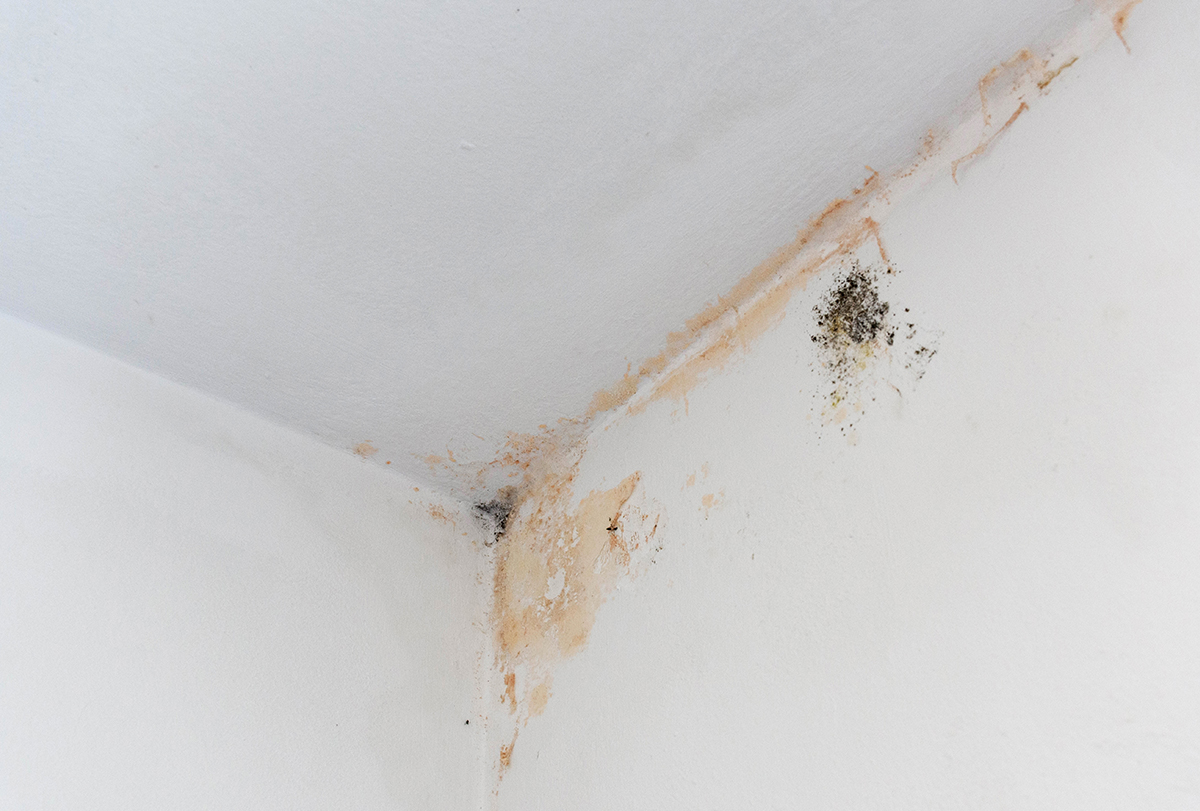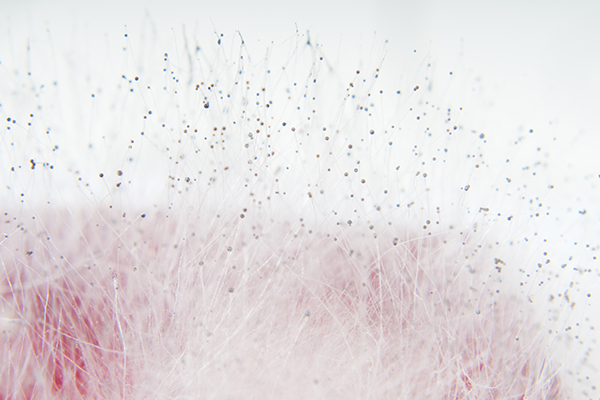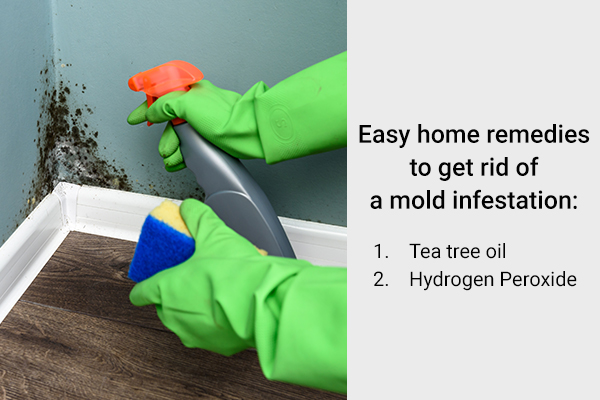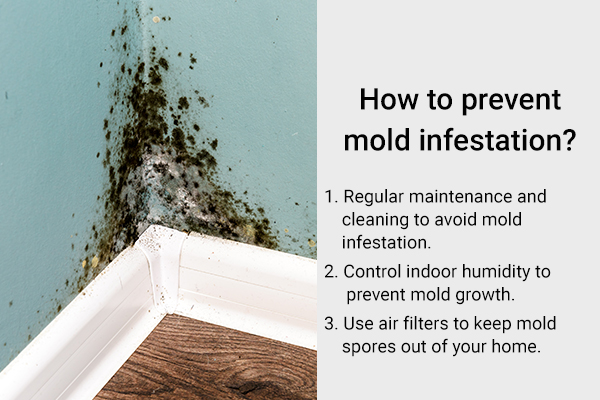In this article:
Yes, many times, a headache is a symptom of mold allergy.

Mold is a common variety of fungi that grows both indoors and outdoors on all kinds of surfaces, particularly in humid and poorly ventilated conditions. It releases spores (seeds) in the air, which can trigger an allergic reaction in some people if inhaled.
If allergies run in your family, you are quite likely to be allergic to mold as well. (1)
Some typical symptoms of a mold allergy include:
This article will focus on one specific symptom of mold allergy – headaches – and how to manage or avoid them. (4)
Why Do Molds Give You Headaches?
Mold contains microbial volatile organic compounds (mVOCs) (5)(6) that can prove toxic inside the body and induce an allergic reaction. Breathing in these allergens irritates the respiratory system.
The body identifies these foreign substances as a threat and triggers an inflammatory immune response to defeat them. This involves increased secretion of mucus inside the respiratory airways and sinus cavity to trap the allergen.
The increased pressure inside the sinuses due to the mucus buildup is responsible for the headaches associated with mold allergies. (7)(8) The severity of these headaches may vary depending upon the extent of mold exposure and your level of sensitivity to it along with other environmental factors.
Mold allergies tend to flare up more during the summer and monsoon seasons when humidity rises, causing increased mold count in the environment.
What Mold Causes Allergic Reactions Along With Headaches?

Molds such as Penicillium, Cladosporium, Aspergillus, and Alternaria are some common types of mold that are known to cause allergic reactions along with headaches. (9)
What Does a Mold Headache Feel Like?
Headaches caused by mold exposure are similar to sinus headaches since both of them are the result of mucus accumulation in the sinus cavity. They are generally characterized by pain and pressure around the forehead, eyebrows, eyes, and even the upper teeth.
How to Identify Mold in Your Home
Mold usually appears in the form of spots that can be green, red, or black. It has a fuzzy texture and musty smell.
If you see or smell mold inside your home, take immediate steps to get it removed regardless of what type of mold it is.
How Do Molds Get Indoors and Grow?
Mold produces tiny spores or seeds that get suspended in the air. These airborne spores can directly enter your home through open doorways, windows, vents, and heating and air conditioning systems.
Plus, mold spores may land on your clothes, shoes, or pets and get carried inside your home. (10)
What Are the Treatments for Mold Infestation?

Here are some easy home remedies to get rid of a mold infestation.
1. Tea tree oil
Tea tree oil (TTO) is a potent antimicrobial agent that can help control mold growth inside your home. (11)
How to use:
- Put on a pair of gloves.
- Pour a glass of water into an empty spray bottle.
- Put a tablespoon of tea tree oil in it.
- Tightly close the lid and give the bottle a good shake so that everything mixes well.
- Spray this solution on all mold-ridden surfaces.
- Do not rinse. Leaving the tea tree oil solution on the surface for 1 hour will kill the mold.
- Scrub and wipe off any remaining debris using your chosen surface cleaner.
- Wipe down the cleaned surfaces with a sponge soaked in clean water.
2. Hydrogen peroxide
Hydrogen peroxide is credited with strong antimicrobial activity, which can help kill the mold in your home or slow its growth.
How to use:
- Mix a few drops of hydrogen peroxide in lukewarm water and spray it on the moldy spots.
- Let it rest for 15 minutes or till the hydrogen peroxide stops bubble formation. (12)
- Clean the mold soaked with the hydrogen peroxide solution using a soft brush.
- Wipe the surface dry with a clean cloth.
- Repeat if necessary.
How to Prevent Mold Infestation
Here are some preventive measures against mold infestation.

1. Maintain and clean your home to avoid mold infestation
- Routinely check your home and office space for any signs of water leakage and mold growth to prevent a full-blown infestation. (10)(13)
- Promote groundwater drainage away from your house.
- Use fans and open doors between rooms to improve air circulation inside the home.
- Shift furniture slightly away from the walls.
- Deep clean your sinks and bathtubs every month, at the very least.
- Turn on the exhaust fan while cooking or washing dishes.
- Regularly clean refrigerator door gaskets and drip pans.
- Don’t leave your damp clothes lying around for too long as they can develop mold growth.
- vDon’t put a carpet in humid spaces such as the basement or bathroom as it tends to soak in moisture and develop mold.
- Make sure your laundry area is properly ventilated.
- Discard old produce before it turns moldy.
- Wear an N95 mask, hat, and sunglasses when gardening.
- Make sure all your rooms get enough sunlight.
2. Control indoor humidity to prevent mold growth
- Look out for any damp surfaces in your home and dry them out at once. This applies especially to your bathrooms, kitchen, and basement, which are more likely to have high humidity and less ventilation.
- Water your potted houseplants and herbs only when the soil feels dry.
- People with mold allergies should avoid going out during humid months when there is a high mold count in the environment. (14)
3. Use air filters to keep mold spores out of your home
- Install a high-efficiency particle air-filtering system (HEPA) in your home.
- Install a certified asthma- and allergy-friendly filter in your central air conditioning system.
- Make sure to replace your air filters when needed. (15)
When to See a Doctor
If you are aware that you have been exposed to mold and become sick thereafter, consult your doctor to get tested for possible allergies and subsequent treatment.
Visit a doctor if you have these symptoms:
- Persistent sinus and nasal congestion
- Recurrent headaches
- Chronic coughing
- Difficulty breathing
- More frequent asthma attacks
Most-Asked Questions About Mold Allergy
What medical tests are available to determine if I am allergic to mold?

Doctors generally diagnose mold allergies through the following steps:
- Medical history
- Physical examination
- Skin test or a blood test
What are some treatments for mold?
Here are some standard medical treatments used for managing mold allergies:
- Antifungals on the advice of doctors
- Corticosteroid nasal sprays to curb inflammation, but care should be taken by patients who have reduced immunity
- Decongestants to improve breathing and relieve congestion
- Allergen-specific immunotherapies (AITs) such as those for Alternaria, which are mostly recommended for patients with allergic rhinitis and/or some types of bronchial asthma (16)
- Saline nasal rinses to eliminate mold spores and mucus from your nasal passages
- Antihistamines to reduce itching, sneezing, and nasal discharge (17)
Is mold dangerous for people with allergies?
Yes, mold can be quite toxic for people with preexisting allergies, chronic respiratory disorders, lung disease, and immune suppression and can result in severe adverse reactions.
Research has shown that a significant portion of the population experiences serious illness due to mold toxicity, including neurological and/or immunological damage. A lot of people even develop chronic respiratory problems from mold exposure accompanied by headaches.
If you have chronic respiratory disease, you may find it difficult to breathe after being exposed to mold. Meanwhile, people with immune suppression or lung ailments can easily contract fungal infections from mold. (18)
Can COVID-19 trigger a fungal infection?
Headache is a common symptom of COVID-19, but if it persists even after 2 weeks of recovery, then it may be a symptom of mucormycosis, or black fungus infection. A lot of COVID-19 patients contracted this rare but dangerous infection during the 2nd wave in the summer of 2021, with the majority of the cases in India.
COVID-19 significantly weakens your immune system and makes you extremely susceptible to various infections, including this one, which is caused by a group of molds called mucormycetes. (19)
The factors responsible for inducing mucormycosis in COVID-19 patients are still being investigated, but the occurrence of severe and persistent headaches should be taken as a warning sign and warrants prompt medical attention to stave off any severe complications.
Final Word
Symptoms of mold infection depend upon the degree of exposure, sensitivity toward the mold, and environmental factors. The greatest method to reduce symptoms is to minimize exposure. Consult a doctor if your symptoms persist for a long period.
- Was this article helpful?
- YES, THANKS!NOT REALLY


